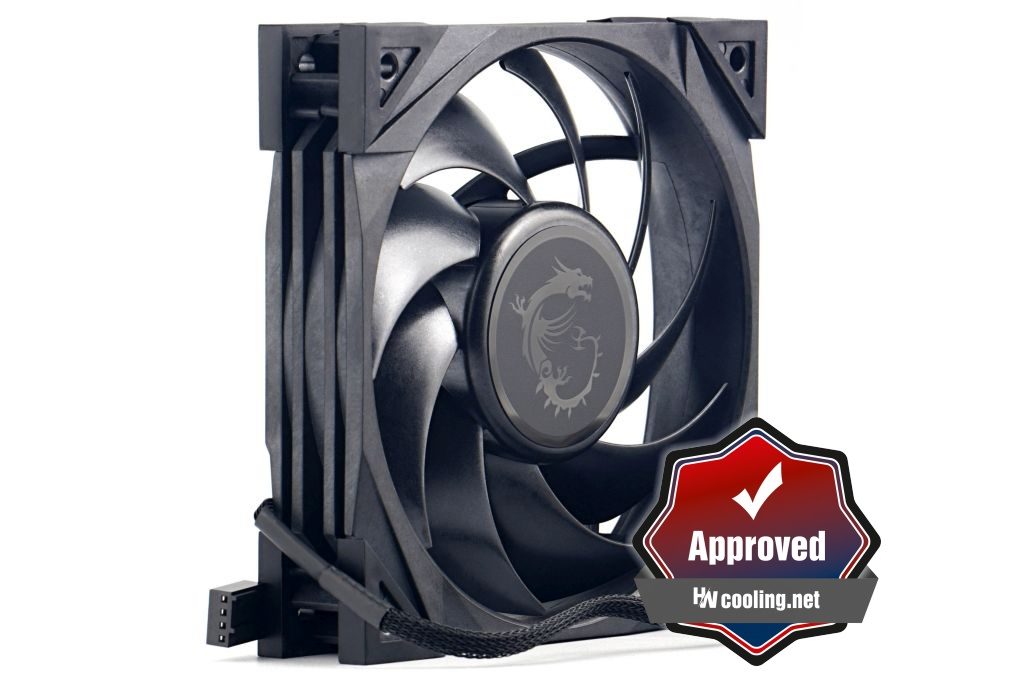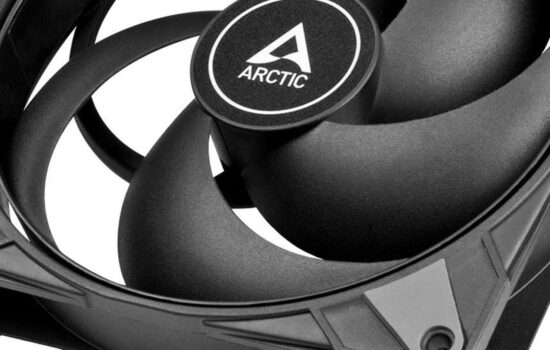Evaluation
While the Silent Gale P12 isn’t the first fan in MSI’s lineup (like the Strix XF120 from Asus), it beats anything previous from the company by a mile. This is by the efficiency of the rotor, which is suitable for radiators as well as for a case, but also by the overall robust design. There’s a big, powerful but quiet motor, and you won’t even know about the hydrodynamic bearings.
Evaluation
The application possibilities of the MSI MEG Silent Gale P12 are exceptionally broad. What does this mean? Firstly, that in addition to the wide speed range (187~1905 rpm) at low PWM intensity, this fan can also run in a passive mode. But that’s just the basics, the important thing is, of course, efficiency and sound. And when the headline talked about versatility, it was because of the fact that the Silent Gale P12 delivers balanced performance on both radiators and grilles within a computer case.
Compared to the Strix XF120, the Strix XF120 is more efficient and at a low noise level (31 dBA) very significantly so. This is the level at which system fans in well-optimised computers operate. Coexisting with a nylon dust filter, it’s additionally completely different music than the fans from the big comparison test. But since it is not a cheap fan, the Silent Gale P12 definitely needs all this.The MSI fan also has a significantly high airflow and also pressure through radiators, so it is without a doubt suitable for this use. The only thing it slightly lags behind the Strix XF120 in is static pressure on radiators at higher noise levels. However, at lower (more acceptable for quiet PCs) levels, it’s all in control of the Silent Gale P12.
It is also worth praising the fact that MSI does not mislead in the specifications. The reported airflow overlaps with our measurements. The specified static pressure values differ more significantly from our measurements, but these are still not dramatic differences. We measured 1.89 mm H2O and the parameters state 2.21 mm H2O. It’s also due to the fact that neither of our samples can do 2000 rpm. The reality is 1900 rpm and it’s questionable whether some pieces will even make it to the paper maximum at 12 PWM controller power. Most of the time, fans are a hair faster, here the opposite is true. But you’ll probably just wave your hand over this one, because either way you’ll be tuning the speed to lower noise levels. And those are good to break down to the individual frequency level.
The sound is clean, aerodynamic (no mechanical components from the bearings and motor), we’ve already mentioned that. However, it is important to add that high (more unpleasant) frequencies are successfully avoided by the Silent Gale P12 and even at high (~1590) speeds it stays in the spectrum of deeper tones. That is, as long as he has no obstacle in front of it. It’s worse with a plastic dust filter, with it, the fan already hisses clearly at 5-7.5 kHz. However, this is not a shortcoming of the Silent Gale, and it applies to other fans as well (including those from Noctua), and in the future it will be interesting to see if any of the models show lower frequencies in this situation.
The more pronounced frequencies with the hexagonal grille are also below 2 kHz (i.e. quite pleasant). So once again we come back to the fact that the MSI fan is really suitable for use in a case as well. Vibrations are, moreover, negligible, so it won’t rattle even on the thinner sheet metal that has become a symbol of contemporary manufacturing. Low vibration intensity or low friction is also associated with low power draw (0.22-1.23 W). However, the motor power is high (4.31 W), which is only good.
On the other hand the scores forairflow per euro and static pressure pre euro are both lacking. The Silent Gale P12 is expensive and certainly more expensive than it would benefit from compared to the Noctua NF-A12x25 PWM chomax.black, compared to which it only has the benefit of the motor shutting down at low speeds. It’s admittedly a harsh statement for an otherwise good fan, but it would probably also be naive to expect Noctua to pull the short end of the stick in key features, it certainly doesn’t. The Silent Gale P12 will therefore have a tough life despite the fact that there is almost nothing to fault it for. But if you come across it at a sale, don’t hesitate for a second.
English translation and edit by Jozef Dudáš
| MSI MEG Silent Gale P12 |
| + Suitable for every use |
| + High airflow and static pressure through restrictive obstacle |
| + Wide speed range plus passive operation |
| + Very low speeds possible (stable from approx. 187 rpm) |
| + Virtually noiseless operation of bearings and motor (no non-aerodynamic noises) |
| + The sound consists of lower (more pleasing to the ear) frequencies |
| + Extremely robust design |
| + Very low power draw (below 1.2 W) considering the high performance |
| + Extra-low, negligible vibration |
| + Really powerful engine |
| + Long service life expectancy |
| - Weaker price/performance ratio |
| - It does not reach the specified 2000 rpm and caps at about 1900 rpm |
| - Price at the level of the better Noctua NF-A12x25 PWM chromax. black |
| Approximate retail price: 31 EUR |
- Contents
- MSI MEG Silent Gale P12 in detail
- The basis of the methodology, the wind tunnel
- Mounting and vibration measurement
- Initial warm-up and speed recording
- Base 7 equal noise levels…
- .. and sound color (frequency characteristic)
- Static pressure measurement…
- … and airflow
- Everything changes with obstacles
- How we measure power draw and motor power
- Measuring the intensity (and power draw) of lighting
- Results: Speed
- Results: Airflow w/o obstacles
- Results: Airflow through a nylon filter
- Results: Airflow through a plastic filter
- Results: Airflow through a hexagonal grille
- Results: Airflow through a thinner radiator
- Results: Airflow through a thicker radiator
- Results: Static pressure w/o obstacles
- Results: Static pressure through a nylon filter
- Results: Static pressure through a plastic filter
- Results: Static pressure through a hexagonal grille
- Results: Static pressure through a thinner radiator
- Results: Static pressure through a thicker radiator
- Results: Static pressure, efficiency by orientation
- Reality vs. specifications
- Results: Frequency response of sound w/o obstacles
- Results: Frequency response of sound with a dust filter
- Results: Frequency response of sound with a hexagonal grille
- Results: Frequency response of sound with a radiator
- Results: Vibration, in total (3D vector length)
- Results: Vibration, X-axis
- Results: Vibration, Y-axis
- Results: Vibration, Z-axis
- Results: Power draw (and motor power)
- Results: Cooling performance per watt, airflow
- Results: Cooling performance per watt, static pressure
- Airflow per euro
- Static pressure per euro
- Results: Lighting – LED luminance and power draw
- Results: LED to motor power draw ratio
- Evaluation












